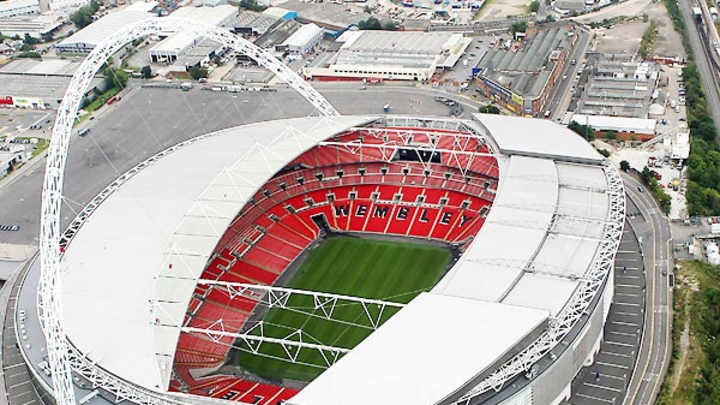New Wembley Stadium nods to its forebearer, seeks own history

The new Wembley Stadium has built a legacy beyond key soccer matches, hosting concerts and NFL games as well. (Tom Shaw/Getty Images)

When it comes time to replace a stadium full of atmosphere, losing it sucks the nostalgia right out of the building. Whether moving next door to a look-a-like venue or ripping down the famed Wembley Stadium in north London, the fresh paint on all the modern amenities doesn’t have the same stories as the 1948 "Austerity Games" that help give venues a place in history.
Without atmosphere, you have only a building. There lies the rub of a stadium sequel.
Hollywood types know they need three key elements for a successful second act – a story true of the original, something new and fresh and a surprise. Stadiums require a fourth point: nostalgia.
Famed architect Lord Norman Foster said “the challenge in reinventing Wembley for a new century was to build on its extraordinary heritage and yet create a venue that would be memorable and magical in its own right.”
In 77 years, old Wembley and its famed Twin Towers had their moments. Originally built for the British Empire Exhibition of 1924, it hosted the Olympics in 1948 and the World Cup Final in 1966, which England scooped up.
But those events serve only as memories. It became an aging stadium, yes, and one that needed tearing down to make way for the 2007 opening of the new venue. Old Wembley, though, was still a stadium with memories to hold it up for future generations.
On the same northwest London site, positioned just some 98 feet to the north to make way for wider concourses and extra amenities, the use of the same site, orientation to the community and open bowl give this stadium an unmistakable nod to the past.
But that original story gets an expansion, one that dwarfs the original. New Wembley stands almost four times the height of the old structure, covering twice the area of the original. In fact—when the retractable roof closes—Wembley is the world’s largest covered arena. The modern amenities are expected, with 688 food and drink service points, matching video boards, 30 escalators, 34 bars and the maligned middle tier of 16,532 luxury seats.
Even the Royal Box sits near the same location in the middle of the northern stands, although the new version has 107 steps from pitch to box instead of the 39 steps of old.
While Foster had the space away from the pitch covered, he wanted to ensure he didn’t lose the “distinctive Wembley roar” from the inside, trying to capture a sense of that nostalgia.
“Its geometry and steeply raked seating tiers ensure that everyone has an unobstructed view of the game,” he says. “The seats are located as close to the pitch as possible.”
Then comes the surprise: a 7,840-ton steel roof structure eliminating the need for pillars that features a 436-foot-tall steel arch supporting a retractable roof. The 1,000-foot span makes it the longest single span roof in the world at over 11 acres, four of which are retractable.
“It is an iconic replacement for the old building’s twin towers,” Foster says. “Floodlit at night, it is a strong symbol for Wembley and an instantly recognizable London landmark.”
From under that arch, Wembley shows versatility by hosting concerts, an ever-increasing rotation of NFL games and its well-known roster of English football contests. This allows us to start asking how the stadium has done expanding the Wembley story without losing the history of old.
New Wembley’s story has really just started, but the London-based memories are already there, whether an extra-time FA Cup thriller in 2007, a Champions League stunner in 2011, an Olympic final in 2012 and, most recently, a climatic Champions League Final in 2013, full of German fans singing, swaying and going generally crazy while filling up Wembley with memories for its 90,000 spectators. Awash in an enrapturing game, surrounded by entranced fans, the stadium becomes a backdrop. And the arch stands into the London horizon, constantly serving as its own backdrop to all the heritage that resides at Wembley.
With a story nodding to the past but full of surprises to fit a sequel, the new Wembley sits just a few classic moments of nostalgia away from defining its own legacy. This sequel demands it.
Tim Newcomb covers stadiums, design and technology for Sports Illustrated. Follow him on Twitter at @tdnewcomb.
WILSON: Time for Man United's Moyes to start showing signs of progress
